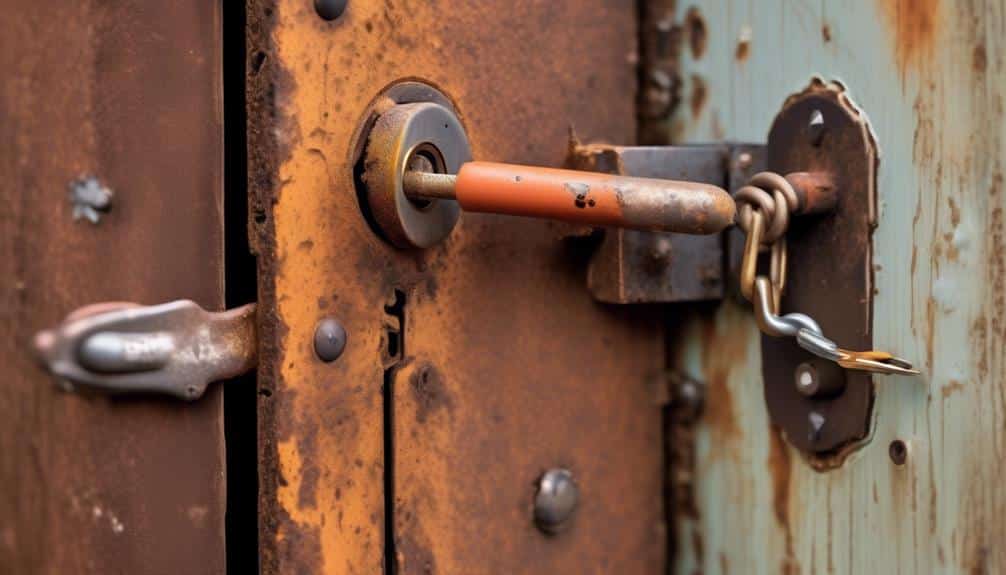Alright folks, gather 'round! We've got a hot topic to discuss today that's sure to pique your interest.
Picture this: you come home after a long day, eager to relax in the comfort of your own space, only to find that your lock is acting up. Frustrating, right?
Well, fear not, because we're here to help. In this discussion, we'll be sharing not one, not five, but fifteen cost-effective lock repair tips that are suitable for any budget.
Whether you're a DIY enthusiast or simply looking for some quick fixes, we've got you covered. So sit tight, because we're about to unlock a wealth of knowledge that will save you time, money, and headaches.
Stay tuned!
Assessing Lock Damage
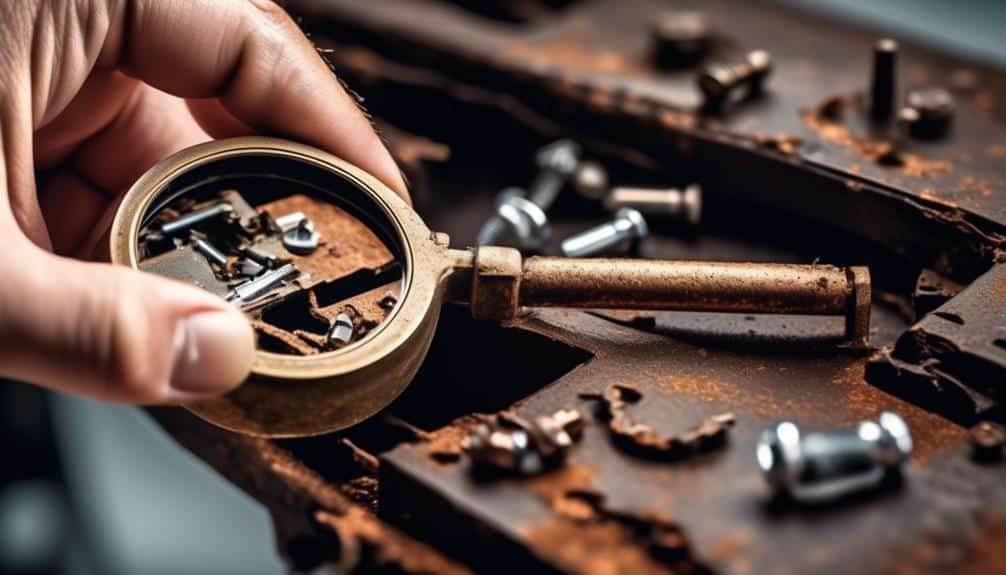
When assessing lock damage, we must conduct a thorough lock inspection to identify any signs of wear, malfunction, or breakage in the lock mechanism. This step is crucial in order to accurately evaluate the lock's functionality and determine the repair needs.
During the lock inspection, we should carefully examine the exterior of the lock for any visible signs of damage, such as scratches, dents, or rust. Additionally, we should check the keyway for any obstructions or debris that may interfere with the key's insertion or turning.
Next, we need to test the lock by inserting the key and turning it to ensure smooth and consistent operation. If there's any difficulty in inserting the key or if the lock feels stiff or loose when turning, it indicates potential issues with the lock's internal components.
Furthermore, it's important to check the alignment of the lock and strike plate to ensure proper engagement. Misalignment can lead to lock failure or difficulty in locking/unlocking the door.
DIY Lock Repair Techniques
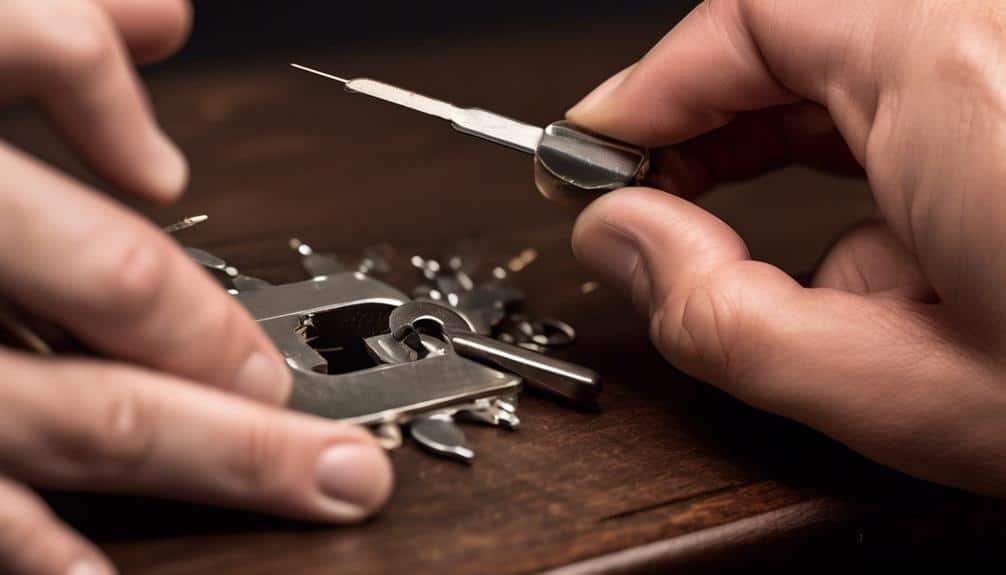
Now that we have thoroughly assessed the lock damage, let's move on to discussing some effective DIY lock repair techniques. When it comes to repairing locks yourself, it is important to have the right tools and take necessary safety precautions. Here are some DIY lock repair tools you will need:
| Tools | Description |
|---|---|
| Screwdriver | Used to remove screws and disassemble the lock |
| Lubricant | Helps to loosen stuck parts and improve lock performance |
| Replacement Parts | Includes springs, pins, and cylinders for lock repair |
Before starting any DIY lock repair, it is essential to follow some safety precautions:
- Always wear protective gloves and goggles to prevent any injury.
- Make sure to have a well-lit workspace to avoid accidents.
- Read the lock repair manual or watch tutorials to understand the process thoroughly.
Lubrication for Smooth Operation
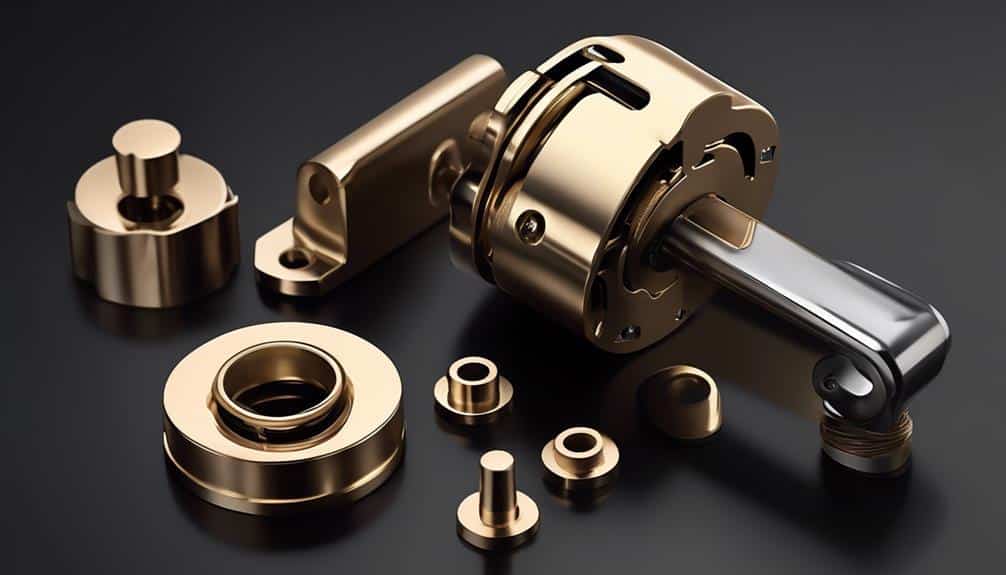
To ensure smooth operation, it's essential to properly lubricate the lock mechanism. Lock lubrication not only helps the lock function smoothly but also prevents lock damage. Over time, locks can become stiff or sticky due to dirt, debris, or lack of lubrication. This can lead to difficulty in inserting or turning the key, or even complete lock failure. By regularly lubricating your locks, you can prevent these issues and extend the lifespan of your locks.
When it comes to lock lubrication, it's important to use the right type of lubricant. Avoid using oil-based lubricants such as WD-40, as they can attract dust and debris, making the problem worse. Instead, opt for a silicone-based or graphite lubricant, specifically designed for locks. These lubricants provide long-lasting protection without attracting dirt.
To lubricate your lock, start by cleaning the lock mechanism using compressed air or a small brush to remove any debris. Then, apply a small amount of lubricant directly into the keyway. Insert and remove the key several times to ensure the lubricant is distributed evenly. Be careful not to over-lubricate, as excess lubricant can lead to buildup and attract more dirt.
Regular lock lubrication not only ensures smooth operation but also prevents lock damage. By following these simple steps, you can keep your locks functioning properly and avoid costly repairs or replacements.
Tightening Loose Locks
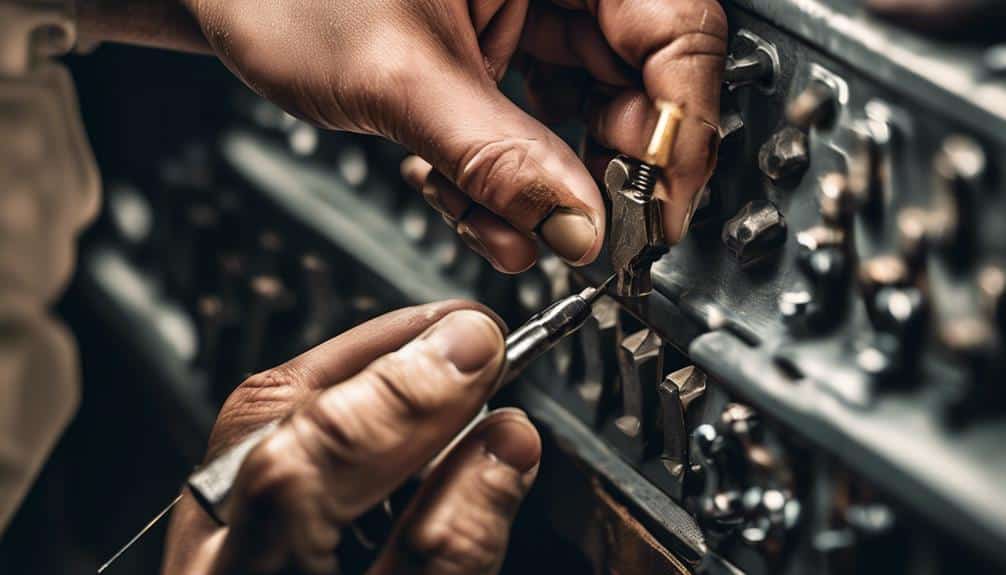
Now let's address the issue of tightening loose locks. When a lock becomes loose, it can affect its functionality and compromise security.
In order to address this problem, there are a couple of key points to consider: lubricating the lock mechanisms and adjusting the strike plate.
Lubricating Lock Mechanisms
To tighten loose locks and ensure smooth operation, lubricating lock mechanisms is a crucial step in lock repair. Proper lubrication techniques not only prevent lock rust but also extend the lifespan of the lock. Here are two essential lubrication tips for maintaining your locks:
- Use graphite lubricant: Graphite lubricant is ideal for locks as it provides long-lasting lubrication without attracting dirt and dust. Apply a small amount of graphite powder directly into the keyhole and work the key back and forth to distribute the lubricant evenly.
- Avoid using oil-based lubricants: While oil-based lubricants may seem like a quick fix, they tend to attract dirt and debris, leading to lock malfunction. Instead, opt for a silicone-based lubricant specifically designed for locks, which offers better protection and longevity.
Adjusting Strike Plate
We can tighten loose locks by adjusting the strike plate. The strike plate is the metal plate attached to the door frame that the lock latch engages with when the door is closed. Over time, the strike plate can become misaligned or loose, causing the lock to not function properly. Fortunately, adjusting the strike plate is a relatively simple and cost-effective solution that can be done with basic tools.
To adjust the strike plate, follow these steps:
| Step | Instructions |
|---|---|
| 1 | Remove the strike plate screws. |
| 2 | Reposition the strike plate to align it with the latch. |
| 3 | Tighten the screws to secure the strike plate in place. |
| 4 | Test the lock to ensure it is working properly. |
If the strike plate is damaged beyond repair, a strike plate replacement may be necessary. This involves removing the old strike plate and installing a new one in its place. Remember to use the appropriate size and type of strike plate for your lock.
Replacing Worn Out Lock Parts
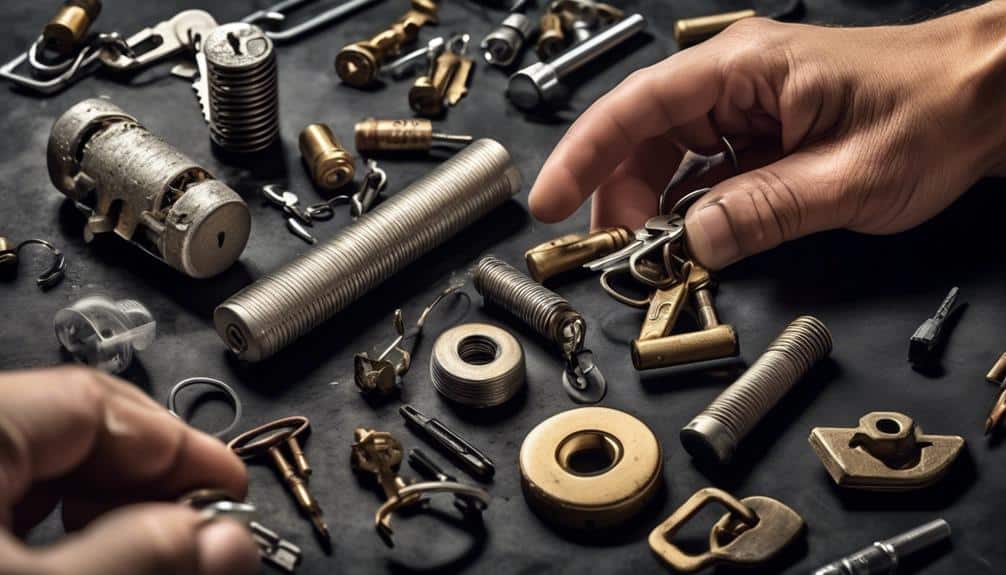
When lock parts become worn out, it's essential to replace them promptly to maintain the security and functionality of the lock. Neglecting to replace worn out lock parts can compromise the safety of your property and increase the risk of break-ins.
Here are two key lock parts that commonly wear out and need replacement:
- Lock Cylinders: The lock cylinder is the part of the lock where you insert the key. Over time, the pins and springs inside the cylinder can wear down, making it difficult to turn the key or causing it to get stuck. To replace the lock cylinder, you'll need to remove the old one and install a new one that matches the brand and model of your lock.
- Lock Latch: The lock latch is the mechanism that extends and retracts when you turn the key or use the door handle. Worn out lock latches can become loose or fail to engage properly, resulting in difficulty locking or unlocking the door. To replace a worn out lock latch, you'll need to remove the old one and install a new latch that matches the specifications of your lock.
Cleaning and Maintaining Locks
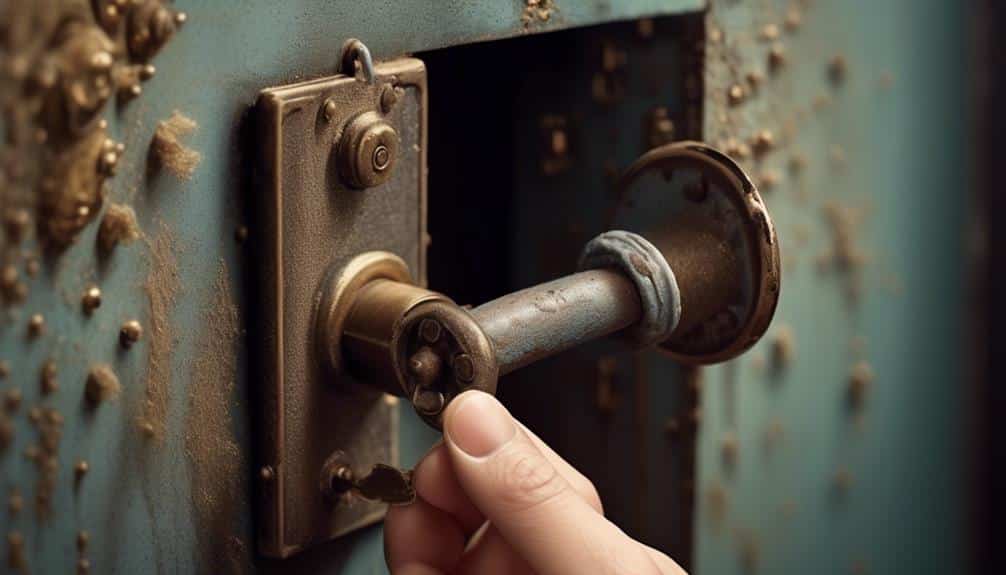
Regular cleaning and maintenance are crucial for ensuring the longevity and optimal performance of your locks. By implementing simple cleaning techniques and taking preventive measures, you can prevent lock damage and avoid costly repairs. Here are some key tips to keep your locks in top shape:
| Cleaning Technique | Preventing Lock Damage |
|---|---|
| Lubrication: Apply a small amount of graphite or silicone-based lubricant to the keyway and moving parts of the lock. This helps reduce friction and keeps the lock mechanism functioning smoothly. | Avoid forcing the key: If the key doesn't turn easily, don't force it. Forcing the key may damage the lock pins or cylinder, leading to lock failure. |
| Dusting: Regularly dust the lock and key with a soft brush or cloth to remove dirt, debris, and lint. This prevents buildup, which can impede the key's insertion and movement within the lock. | Keep keys clean: Avoid exposing keys to moisture, dirt, or harsh chemicals, as these can corrode the key and cause it to stick or break in the lock. |
| Cleaning solution: For stubborn dirt or grime, use a mild cleaning solution to gently clean the lock and key. Avoid using abrasive cleaners or excessive moisture, as these can damage the lock's finish or internal components. | Protect from extreme temperatures: Extreme heat or cold can cause locks to expand or contract, affecting their functionality. Consider installing weatherproof seals or covers to shield locks from extreme weather conditions. |
Repairing Jammed Locks
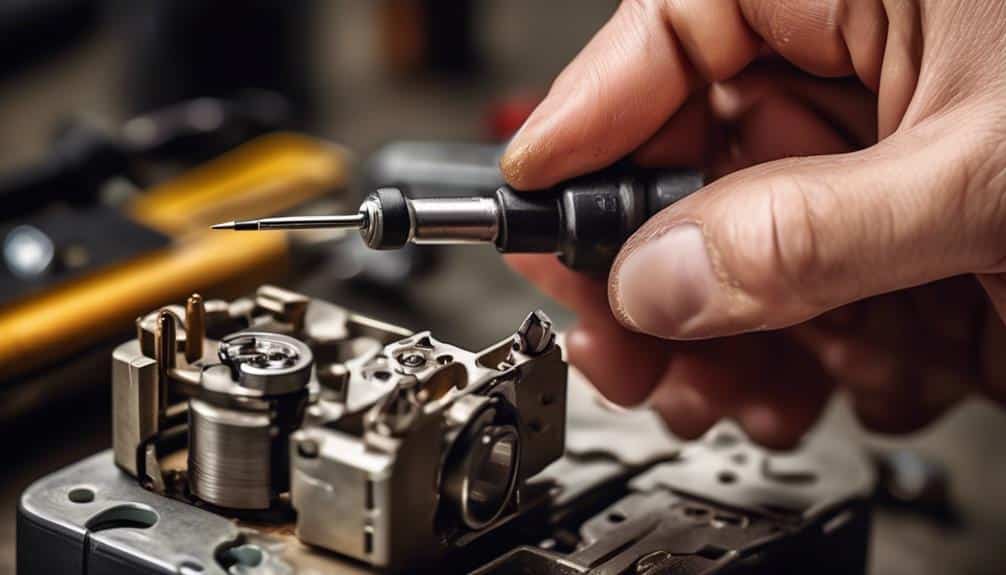
To repair a jammed lock, start by assessing the cause of the jam and determining the appropriate course of action. Assessing lock functionality is crucial in order to understand why the lock is jammed and what needs to be done to fix it.
Here are some common lock jamming causes and the steps you can take to repair them:
- Misalignment:
- Check if the strike plate is properly aligned with the latch. If it's not, adjust it accordingly using a screwdriver.
- Examine the alignment of the lock cylinder and make sure it's properly inserted into the strike plate.
- Key Issues:
- Inspect the key for any signs of damage or bending. If necessary, replace the key.
- Lubricate the lock cylinder with graphite or silicone spray to ensure smooth operation.
- Dirt and Debris:
- Clean the lock cylinder using compressed air or a cotton swab dipped in rubbing alcohol.
- Remove any dirt or debris from the strike plate and latch with a toothbrush or a small brush.
Remember to test the lock functionality after each repair step to ensure it's working smoothly. If the lock continues to be jammed, it may be time to consult a professional locksmith for further assistance.
Fixing Sticking Key Issues
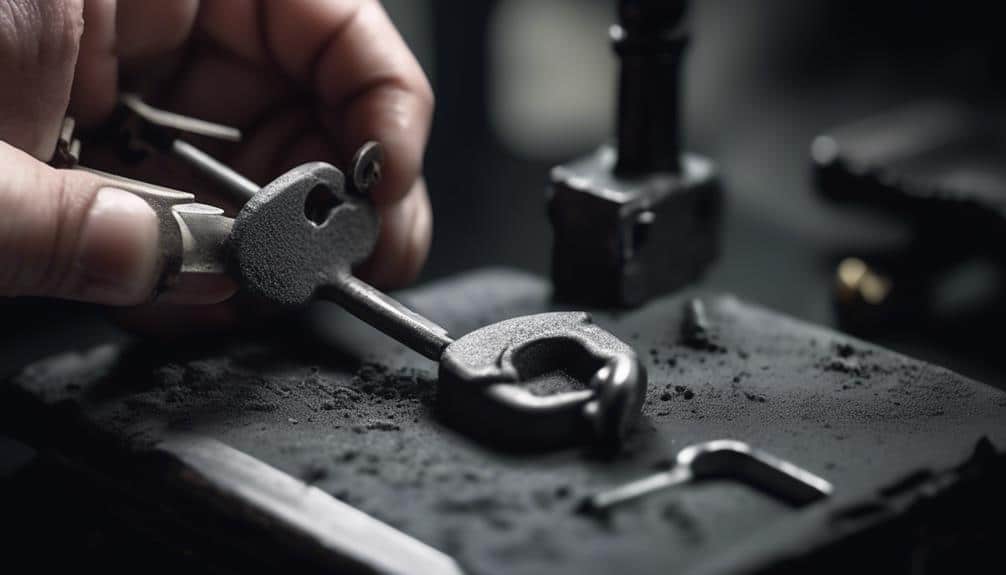
If your key is sticking in the lock, there are a few simple steps you can take to resolve the issue.
One common cause of sticking keys is lack of lubrication. Over time, dirt and debris can accumulate in the lock, causing friction and making it difficult for the key to turn smoothly.
To fix this problem, you can try using a graphite lubricant. Graphite is an excellent lubricant for locks because it's dry and won't attract dust and grime. Simply insert the nozzle of the lubricant into the lock and spray a small amount of graphite. Then, insert and remove the key several times to distribute the lubricant evenly.
If the key still sticks after lubrication, it may be a sign of a more serious problem. In such cases, it's best to seek the help of professional locksmith services. They have the expertise and tools to diagnose and fix complex lock issues, ensuring that your locks work smoothly and securely.
Adjusting Lock Alignment
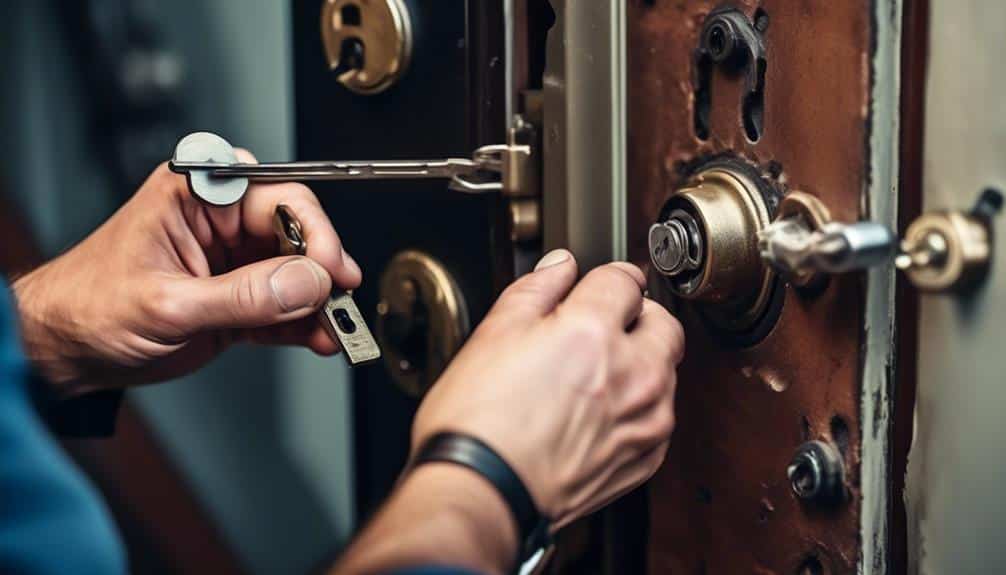
Now let's talk about adjusting lock alignment.
When it comes to fixing lock alignment, there are various techniques that can be used.
We'll also discuss some of the common issues that can arise with lock alignment.
Alignment Adjustment Techniques
Using a level surface and a screwdriver, we can easily adjust the alignment of a lock to ensure optimal functionality. Here are two effective techniques for aligning a lock:
- Adjusting the latch mechanism:
- Start by loosening the screws on the latch plate with a screwdriver.
- Gently push or pull the latch to align it with the strike plate.
- Tighten the screws to secure the latch plate in place.
- Realigning the deadbolt:
- Insert the key and turn the lock to the unlocked position.
- Loosen the screws on the strike plate.
- Gradually move the strike plate up, down, left, or right until the deadbolt smoothly enters the strike plate hole.
- Tighten the screws to secure the strike plate in its new position.
Common Lock Alignment Issues
To effectively adjust the alignment of a lock, it's important to address common lock alignment issues.
Proper lock installation and regular lock maintenance are key factors in preventing misalignment.
One common issue is when the lock cylinder isn't properly aligned with the strike plate. This can occur due to loose screws or worn-out parts. To fix this, tighten any loose screws and replace any worn-out parts.
Another common issue is when the lock latch doesn't properly engage with the strike plate. This can be caused by a misaligned strike plate or a worn-out latch. To resolve this, adjust the strike plate position or replace the latch if necessary.
Repairing Broken Key Extraction
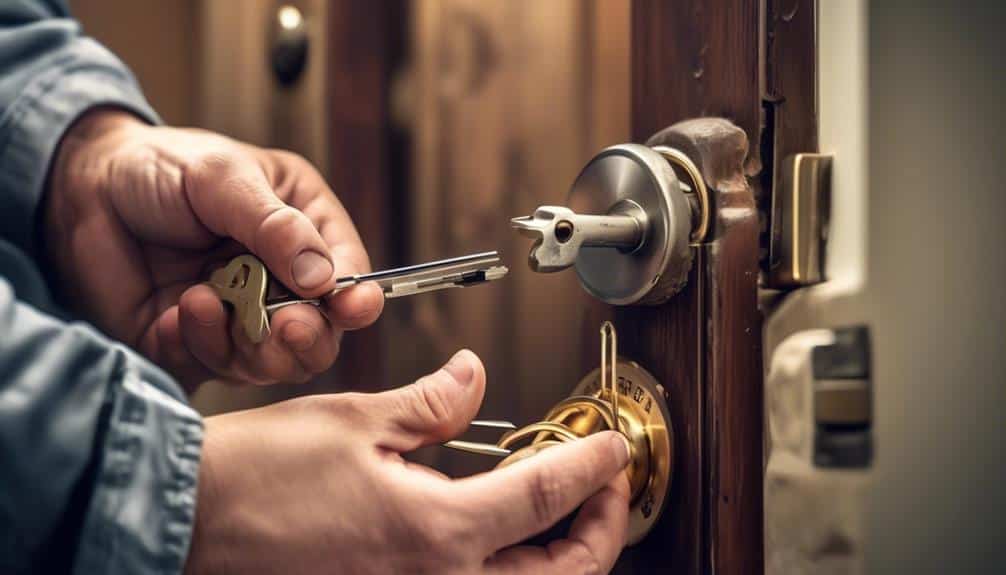
When dealing with the task of repairing broken key extraction, it's essential to approach the problem with caution and precision. Broken keys can be a frustrating and inconvenient issue, but with the right techniques, you can successfully extract the broken piece from the lock. Here are some cost-effective tips to help you with this task:
- Use tweezers or needle-nose pliers: Gently insert the tweezers or needle-nose pliers into the lock and carefully grasp the broken key piece. Slowly pull it out, being careful not to force it or push it further into the lock.
- Apply lubricant: If the broken key piece is stuck and won't come out easily, try applying a small amount of lubricant, such as WD-40, into the lock. This may help loosen the key and make it easier to extract.
When it comes to broken key extraction, it's important to remember that patience and precision are key. If you're unsure or uncomfortable with attempting the extraction yourself, it's best to seek the assistance of a professional locksmith. They have the experience and tools necessary to safely remove the broken key without causing further damage to the lock.
In addition, if the key is irreparably damaged, you may need to consider lock key duplication as a solution. A locksmith can create a duplicate key based on the broken key's pattern, allowing you to continue using the lock without any issues.
Rekeying Locks for Added Security
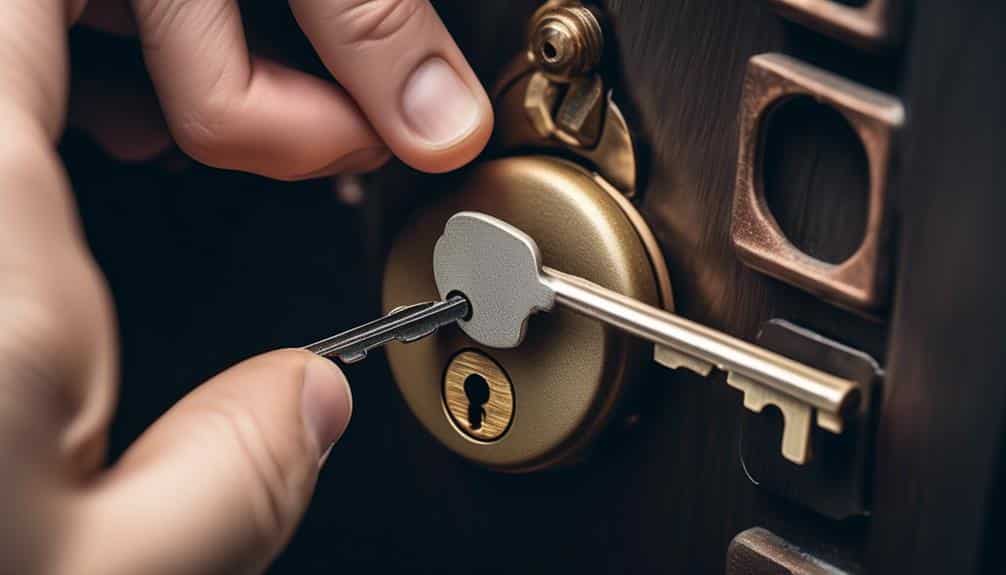
Now let's talk about rekeying locks for added security.
When it comes to key replacement options, rekeying is a smart choice that offers several benefits. By rekeying your locks, you can prevent unauthorized access and ensure that only those with the new keys can enter your property.
It's important to know when to rekey locks, such as after moving into a new home or if you've lost track of who's copies of your keys.
Key Replacement Options
One effective way to enhance the security of your locks is by rekeying them, providing key replacement options. Rekeying involves changing the internal components of the lock so that it can be operated by a new key. This eliminates the need to replace the entire lock, saving you time and money.
When considering key replacement options, there are two main choices to consider:
- Key Duplication Services:
Many hardware stores offer key duplication services, allowing you to make copies of your keys quickly and easily. This can be a convenient option if you simply need extra copies for family members or as backups.
- Professional Locksmith Services:
For added security, it's recommended to hire a professional locksmith to rekey your locks. They have the expertise and specialized tools to ensure that the job is done correctly, minimizing the risk of any errors or security breaches.
Benefits of Rekeying
To enhance the security of your locks and ensure added protection, rekeying them is a highly recommended solution. Rekeying is the process of changing the internal pins and springs of a lock so that it can only be opened with a new set of keys. This provides several benefits and advantages, making it a popular choice for homeowners and business owners alike.
Here are the key benefits of rekeying:
| Enhanced Security | Rekeying your locks eliminates the risk of unauthorized access with old keys. It gives you complete control over who has access to your property. | |
| Cost Savings | Rekeying is a more cost-effective option compared to replacing the entire lock. It allows you to keep your existing hardware while still improving security. | |
| Convenience | Rekeying can be done quickly and easily by a professional locksmith, minimizing any inconvenience or disruption to your daily routine. |
When to Rekey Locks
Rekeying locks is an essential step in enhancing security and providing added protection for your property. Knowing when to rekey locks can save you from potential security breaches.
Here are some scenarios where rekeying is highly recommended:
- Moving into a new property:
Rekeying the locks when moving into a new property ensures that only you have access to the keys, eliminating the risk of unauthorized entry.
- Lost or stolen keys:
If you misplaced your keys or they were stolen, rekeying the locks prevents anyone from using the old keys to gain access to your property.
The rekeying process involves changing the lock's internal pins and springs to match a new set of keys. By rekeying your locks, you can enjoy the benefits of added security without the cost of replacing the entire lock mechanism.
It's a smart and cost-effective solution to safeguard your property and provide peace of mind.
Repairing Electronic Lock Malfunctions
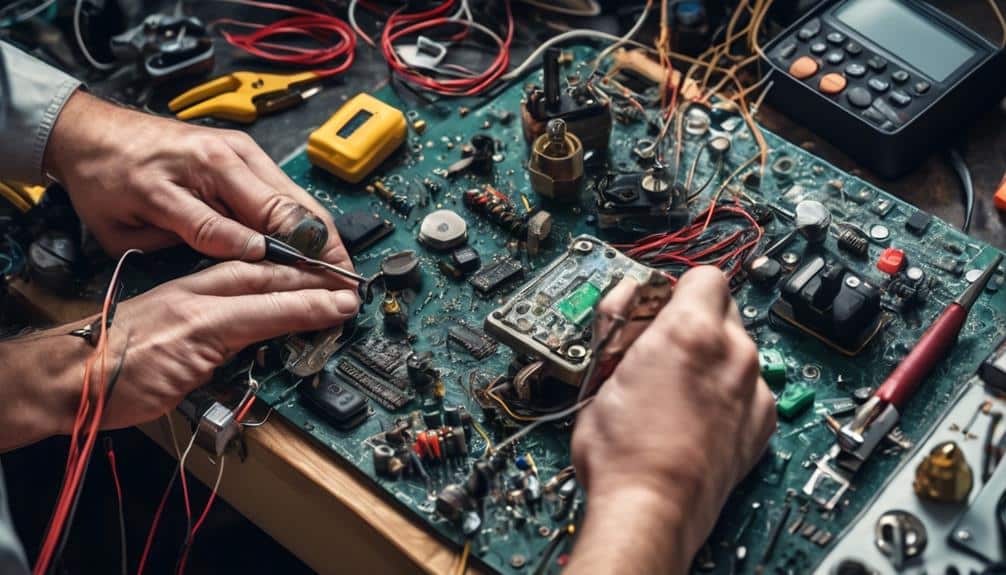
When electronic locks malfunction, it is crucial to promptly address the issue to ensure the security of your property. Troubleshooting electronic locks can be challenging, but with the right knowledge and tools, you can fix keypad malfunctions and restore the functionality of your lock.
One common issue with electronic locks is keypad malfunctions. If the keypad is not responding or displaying error messages, there are a few steps you can take to troubleshoot and fix the problem. First, check the batteries and replace them if necessary. Sometimes, a weak battery can cause keypad malfunctions. If that doesn't solve the issue, try cleaning the keypad with a soft, dry cloth to remove any dirt or debris that may be affecting its performance. If the problem persists, you may need to reset the lock to its factory settings or contact the manufacturer for further assistance.
Here is a table summarizing the troubleshooting steps for fixing keypad malfunctions:
| Step | Action |
|---|---|
| 1 | Check the batteries and replace if necessary |
| 2 | Clean the keypad with a soft, dry cloth |
| 3 | Reset the lock to its factory settings |
| 4 | Contact the manufacturer for further assistance |
Fixing Locks With Alignment Issues
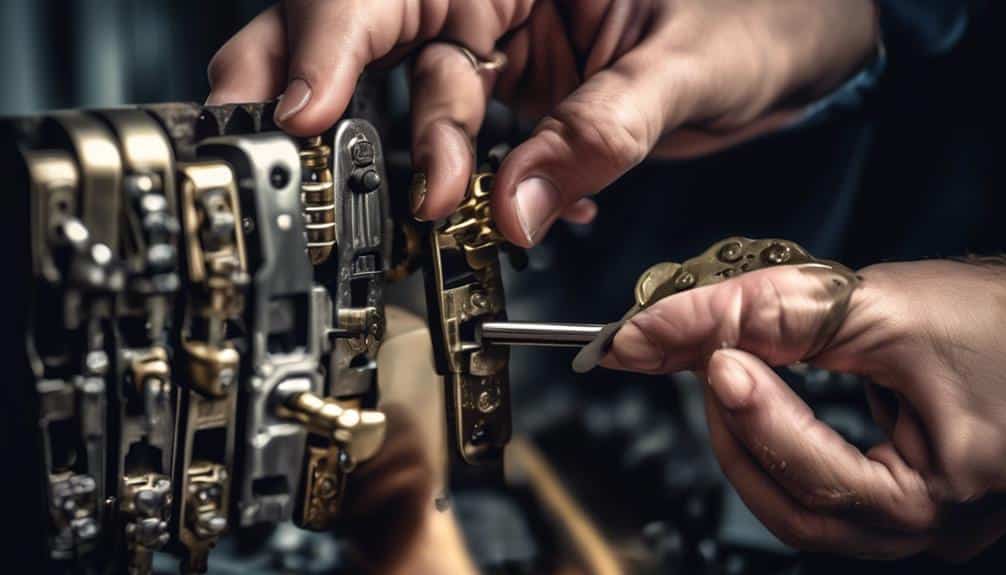
Locks with alignment issues can often be fixed by adjusting the strike plate or the door latch. When a lock is misaligned, it can cause difficulty in smoothly opening or closing the door. Here are some alignment adjustment techniques to help you fix common lock alignment issues:
- Adjusting the Strike Plate:
- Use a screwdriver to loosen the screws on the strike plate.
- Gently move the strike plate up, down, left, or right until it aligns with the latch.
- Tighten the screws to secure the strike plate in its new position.
- Adjusting the Door Latch:
- Remove the latch plate by unscrewing it from the door jamb.
- Slide the latch plate up, down, left, or right to align it with the strike plate.
- Screw the latch plate back into place.
Repairing Locks With Broken Springs
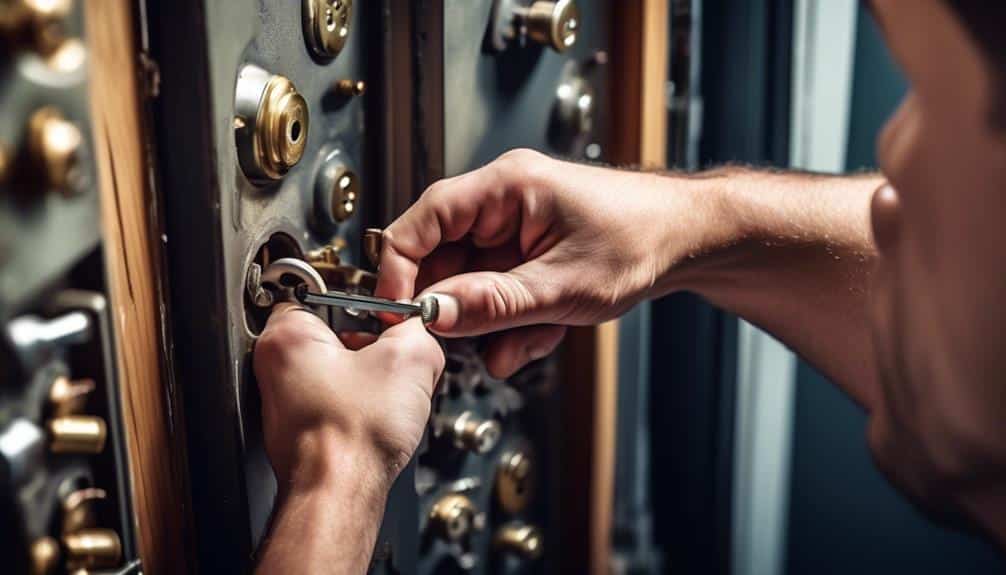
To repair locks with broken springs, we'll need to disassemble the lock mechanism. Broken springs can cause your lock to malfunction, making it difficult or impossible to open or close your door. Fortunately, replacing a broken spring is a relatively straightforward task that can be done without the need for professional lock repair services.
Start by removing the lock from the door. Use a screwdriver to remove the screws holding the lock in place. Once the lock is detached, carefully disassemble the lock mechanism, paying attention to the position of each component.
Locate the broken spring and remove it from the lock. Take note of the size and type of the broken spring so you can find a suitable replacement. Broken spring replacement kits are readily available at hardware stores and online.
Install the new spring by following the manufacturer's instructions. Make sure it's properly aligned and secured in place. Reassemble the lock mechanism and attach it back onto the door.
With a bit of patience and the right tools, you can easily repair locks with broken springs. This cost-effective solution will save you money compared to hiring professional lock repair services.
Troubleshooting Lock Mechanism Failure
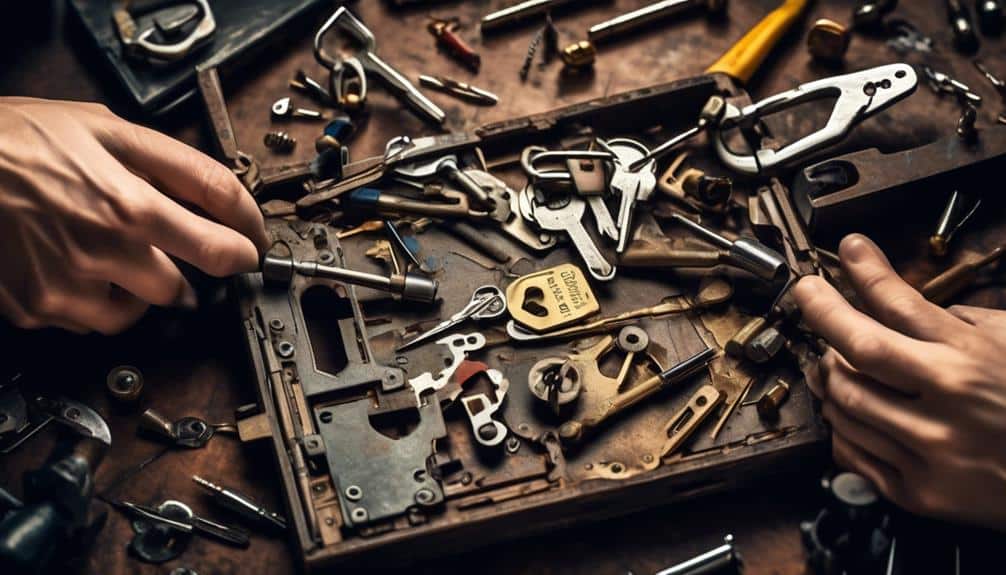
If you're experiencing lock mechanism failure, there are several troubleshooting steps you can take to identify and resolve the issue.
- First, check the lock cylinder for any issues. Ensure that the key is inserted correctly and try turning it gently to see if it engages the mechanism. If the key doesn't turn smoothly or gets stuck, there may be debris or dirt inside the cylinder. Use a lubricant specifically designed for locks to clean it.
- Next, inspect the lock latch for any problems. Check if the latch is properly aligned with the strike plate on the door frame. Adjust the strike plate if necessary. Test the latch by closing the door and attempting to lock it. If the latch doesn't fully extend or retract, it may need to be adjusted or replaced.
- If troubleshooting the lock cylinder and latch doesn't resolve the issue, there may be a more significant problem with the lock mechanism. In this case, it's recommended to contact a professional locksmith for further assistance.
Frequently Asked Questions
What Are the Most Common Causes of Lock Damage?
The most common causes of lock damage are wear and tear, improper maintenance, and attempted break-ins.
Locks can become worn over time, leading to difficulty in turning the key or the lock not functioning properly.
Lack of regular lock maintenance can also contribute to damage.
Additionally, attempted break-ins can result in forced entry, damaging the lock mechanism.
In such cases, it's important to seek professional locksmith services for repair or replacement to ensure proper security and functionality.
How Can I Prevent My Locks From Becoming Loose?
Preventing locks from becoming loose is a priority for us all. DIY lock maintenance is key. Regularly checking and tightening screws, lubricating keyholes, and ensuring proper alignment can help keep locks secure.
It's essential to stay vigilant and address any issues promptly to prevent further damage. By taking these simple steps, we can save ourselves from the hassle and cost of lock repairs.
Are There Any Specific Cleaning Products Recommended for Maintaining Locks?
When it comes to lock maintenance, it's important to use the right cleaning products. There are several options available, but not all of them are recommended.
We suggest using a mild detergent or soap mixed with warm water to clean your locks. Avoid harsh chemicals or abrasive cleaners, as they can damage the lock mechanism.
Regularly cleaning your locks will help prevent dirt and debris from causing them to become loose or malfunction.
Can I Repair a Jammed Lock Without Professional Help?
We can definitely repair a jammed lock without professional help! There are DIY lock repair options available for those on a budget.
All you need are a few essential tools for lock repair, such as a screwdriver, lubricant, and a wire hanger.
What Are the Signs That Indicate the Need for Rekeying a Lock?
When it comes to rekeying locks, there are several signs to look out for. If you notice that your keys aren't working smoothly or if the lock is sticking or jamming frequently, it might be time to consider rekeying.
Additionally, if you have experienced a break-in or lost your keys, rekeying is a good idea to ensure the security of your home or office.
Rekeying involves changing the pins inside the lock cylinder, which is a cost-effective alternative to lock cylinder replacement.

